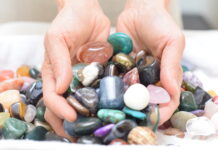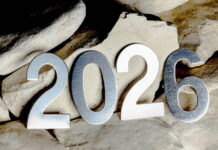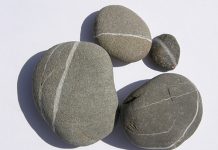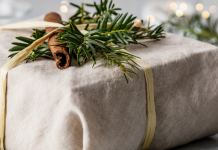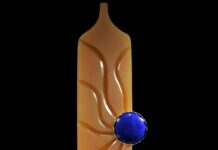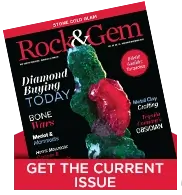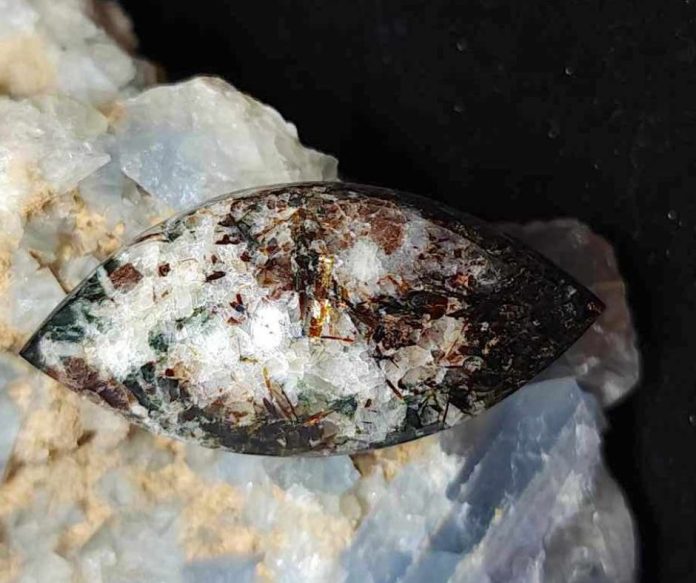
Astrophyllite is a name that comes from the Greek words “astron” & “phyllon,” meaning star and leaf. This rare material was originally discovered on the Laven Island of Norway in the mid-1800s. It has since been found in random places around the world, but the main sources are still Norway and the Kola Peninsula in Russia.
Why Cut Astrophyllite?
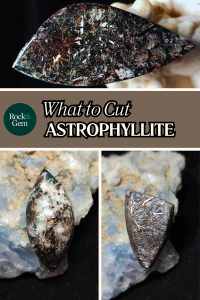
Astrophyllite forms in small golden metallic blades radiating outward, giving it its recognizable starburst or fireworks appearance. It is a highly collectible mineral specimen in situ. It also cuts and polishes extremely well to create cabochons for jewelry.
Though it’s a rare material, it can still be found online and at rock shows. Finding lapidary-grade material is fairly easy. You can generally see on the outer sides how much of the starburst pattern you will get to work with. Many times, you find rough pieces with just staggering spikes randomly placed throughout the host stone. These also make nice cabochons, as the spikes glimmer in the light, making eye-catching jewelry pieces.
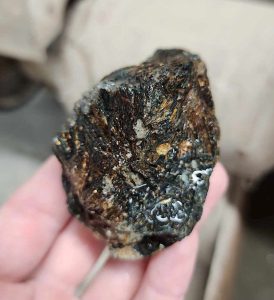
Best Methods to Slab Rough Material
When starting to slab the rough material, be aware that it’s an extremely soft stone, just a three on the Mohs scale of hardness. It’s best to wash the rough first with a soft toothbrush to examine where all the best starburst patterns are located and carefully slab those on a small trim saw. The patterns might darken up on the inside and not be quite as prominent to the naked eye until polished. That’s where the spikes will really shine.
Once you cut slabs, generally there will be a nice contrast between the host stone and the astrophyllite; however, sometimes it may contain heavier amounts of astrophyllite and it will look solid brown at first. Not to worry. Once you start the cabbing process, you will see the patterns start to show and glimmer.
How to Cab Astrophyllite
There are a couple of ways to cab this material. The first is a traditional shape, dome and polish on all edges. The second, because of the exterior patterns, is to trim your cab out and shape the bezel. Instead of doming the top, you can leave it natural and just put a 45-degree edge on it that you can polish. The natural top can be very attractive leaving the exposed needles as they were in situ.
To start the cabbing process, remember that it’s a soft stone and will grind down rapidly if you are not careful. I would still start on an 80-grit steel wheel to shape and dome, but do it gently, and don’t worry about smoothing it out just yet. After your preform cab is shaped and ready to go to the next step, I suggest going straight to your next soft resin wheel, whether 220-grit or up to 280-grit. The material is soft enough to be sanded down and smoothed over by the 280, and at this point, try to get as many of the scratches out as possible. The starburst patterns will be somewhat sparkly in direct light but won’t completely show the full pattern just yet.
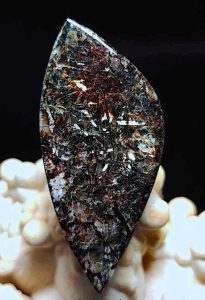
Tips for Polishing Astrophyllite
From this point, doing the main cleanup on the 600 soft resin wheel is important. Be sure to remove all the scratches and you should be able to see it start to polish up by now.
To finish up, run through your 1200-grit, up to either 3k-grit or 8k-grit and it should reflect a beautiful high gloss polish. If you want to gain more of a mirror polish, using cerium oxide on a damp leather buff works well, or use Zam polishing compound and a felt tip on a Foredom rotary tool, or even a Dremel tool. This will heighten the polish and the starburst spikes should really gleam.
This story about astrophyllite previously appeared in Rock & Gem magazine. Click here to subscribe. Story by Russ Kaniuth.


